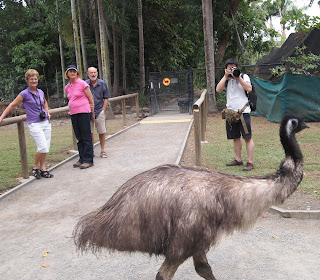Out on the patio we’d sit,
And the humidity we’d breathe,
We’d watch the lightning crack over canefields
Laugh and think, this is Australia.
Heard of the Magnificent Six? If you have the imagination to double that ominous force, you will appreciate the impact that faced Port Douglas when 12 friends from the $20 Walking Group landed on its doorstep. Who are the Awesome Twelve??? well:
 |
| Merille, Graeme, Kathie, Jeff, Col, Joye, Joan, Duncan, John, Jenny (Missing are photographers Jan and Don) |
- Graeme and Kathie Woodley (Graeme is the self-appointed patron saint and founder of the walking group)
- Jeff and Joan Mildren (Jeff is the treasurer of the party and has been a great unifying influence on the group... his influence based on his habit of collecting money before excursions... so everyone follows him to get some value... take their wallets, and their hearts and minds are sure to follow)
- Duncan and Merille McAllan (who both have vast experience of birds, fish and plants)
- John and Jenny Hodges (being the keepers of good taste and style... values the rest of us sadly lack)
- Col and Jan Snodgrass (Jan being the group leader in photographer skills... when Jan points her camera in a direction, we all race to take the same shot)
- Don and Joye Walsh (who are useful for fetching and heavy lifting)
We travelled to Port Douglas on the previous day. Graeme, Kathie Joye and Don saved money by catching an early JetStar flight. A charter bus met us at Cairns airport and arrived at Port Douglas at 11:00 AM. We did a quick reconnoitre of the shopping strip in time to welcome the arrival of the rest of our group commuting at a more civilised time (Jeff, Joan, John, Jenny, Col and Jan).
The rest of the day was taken at a steady pace...swimming pool, naps, reading etc. in preparation for the Cape Tribulation safari on Thursday 9 June. The greatest excitement activity in the afternoon was negotiating car hire deals to display this highly prized skill. Col arrived late so he was at some disadvantage. He visited the Avis shop where he had previously made his reservation. To his disappointment, the car he had booked was not available... the upgrade vehicle Avis had intended to offer Col had been gazumped by Jeff in a bout of frenzied negotiation... so Col had to settle for an upgrade on an upgrade with a 4-wheel drive X-Trail... well suited to some of the rough bush tracks we would later travel. Jeff felt happy with his upgraded Calais until he realised its low ground clearance would cause him worries. Graeme, was most eager to display his superior negotiating skills and ran from one car hire shop to the next, only to suffer disappointment in seeing the pool of available cars evaporate before his eyes. He had to finally accept a Mitsubishi at a price that did not reflect any upgrades. He was distraught but put on a brave face!
This first outing displayed the logistical difficulties that plagued our activities for the whole week. You see, we had no fixed plan, and needed to carry a 'chinese whisper line' of 12 individually minded people. At some points of time, we agreed on a plan that was understood by all... only to have a sub-group meet to amend the plan... but not have all of the 12 people informed.
On the day's trip to Cape Tribulation, the majority of our group worked to the plan of bringing our own lunch. Joye and Don worked to the earlier (redundant) plan of finding a restaurant on the Cape. They ended up dining on the charity of those who could spare a few crumbs from their bulging hampers.
The first evening we dined at the up-market 2-Fish restaurant. We enjoyed the warm balmy evening especially when we started getting news of the cold southerly front that had hit Sydney.
 |
| Sugar Cane in flower |
 |
| Defaced Road signs - forget the road bump - think of the dead Cassowary |
We reached the end of the tarmac at Cape Tribulation. The road is narrow and winding... not at all like the 4-lane highway Joh Bjelkie-Peterson planned for the area. Cape Tribulation was named by British navigator Lieutenant James Cook on 10 June 1770 (log date) after his ship hit a reef as it passed over it, north east of the cape, at 6pm. This made Cook pull away from the coast, looking for deeper water. At 10.30pm, the Endeavour hit a reef almost sinking Cook's ship, on what is now named Endeavour Reef. Cook recorded "...the north point [was named] Cape Tribulation because here began all our troubles".
 |
| Healthy mangroves on the beach |
After lunch we took a walk on a board-walk through rainforest with a thick underlay of fan palms. The walk took us out to the beach where we talked to a group of 'beach-bums' practising their para-surfing skills. One of these apparent 'beach-bums' had a PHD, had just left an important post in Japan where he provided interpreter skills, and was now assisting in running up a 'forest surfing' tourist attraction. We were reminded 'not to judge any book by its cover'.
We made our way back to the motel well satisfied with a long day of sharing one of the world's unique environments.
For our evening meal, the Woodleys and McAllans purchased roasted chicken and salads. We sat around the pool at the motel and reminisced over the adventures of the day.
































